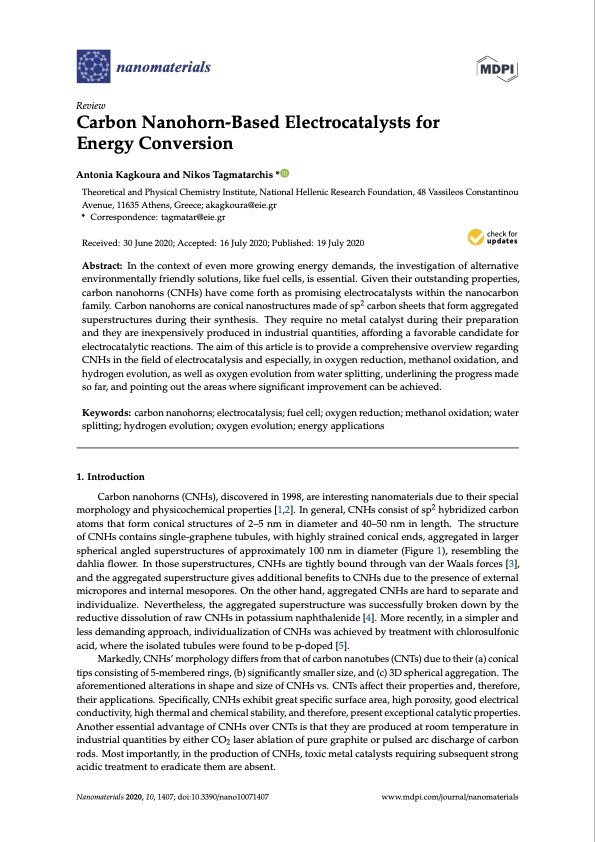
PDF Publication Title:
Text from PDF Page: 001
nanomaterials Review Carbon Nanohorn-Based Electrocatalysts for Energy Conversion Antonia Kagkoura and Nikos Tagmatarchis * Theoretical and Physical Chemistry Institute, National Hellenic Research Foundation, 48 Vassileos Constantinou Avenue, 11635 Athens, Greece; akagkoura@eie.gr * Correspondence: tagmatar@eie.gr Received: 30 June 2020; Accepted: 16 July 2020; Published: 19 July 2020 Abstract: In the context of even more growing energy demands, the investigation of alternative environmentally friendly solutions, like fuel cells, is essential. Given their outstanding properties, carbon nanohorns (CNHs) have come forth as promising electrocatalysts within the nanocarbon family. Carbon nanohorns are conical nanostructures made of sp2 carbon sheets that form aggregated superstructures during their synthesis. They require no metal catalyst during their preparation and they are inexpensively produced in industrial quantities, affording a favorable candidate for electrocatalytic reactions. The aim of this article is to provide a comprehensive overview regarding CNHs in the field of electrocatalysis and especially, in oxygen reduction, methanol oxidation, and hydrogen evolution, as well as oxygen evolution from water splitting, underlining the progress made so far, and pointing out the areas where significant improvement can be achieved. Keywords: carbon nanohorns; electrocatalysis; fuel cell; oxygen reduction; methanol oxidation; water splitting; hydrogen evolution; oxygen evolution; energy applications 1. Introduction Carbon nanohorns (CNHs), discovered in 1998, are interesting nanomaterials due to their special morphology and physicochemical properties [1,2]. In general, CNHs consist of sp2 hybridized carbon atoms that form conical structures of 2–5 nm in diameter and 40–50 nm in length. The structure of CNHs contains single-graphene tubules, with highly strained conical ends, aggregated in larger spherical angled superstructures of approximately 100 nm in diameter (Figure 1), resembling the dahlia flower. In those superstructures, CNHs are tightly bound through van der Waals forces [3], and the aggregated superstructure gives additional benefits to CNHs due to the presence of external micropores and internal mesopores. On the other hand, aggregated CNHs are hard to separate and individualize. Nevertheless, the aggregated superstructure was successfully broken down by the reductive dissolution of raw CNHs in potassium naphthalenide [4]. More recently, in a simpler and less demanding approach, individualization of CNHs was achieved by treatment with chlorosulfonic acid, where the isolated tubules were found to be p-doped [5]. Markedly, CNHs’ morphology differs from that of carbon nanotubes (CNTs) due to their (a) conical tips consisting of 5-membered rings, (b) significantly smaller size, and (c) 3D spherical aggregation. The aforementioned alterations in shape and size of CNHs vs. CNTs affect their properties and, therefore, their applications. Specifically, CNHs exhibit great specific surface area, high porosity, good electrical conductivity, high thermal and chemical stability, and therefore, present exceptional catalytic properties. Another essential advantage of CNHs over CNTs is that they are produced at room temperature in industrial quantities by either CO2 laser ablation of pure graphite or pulsed arc discharge of carbon rods. Most importantly, in the production of CNHs, toxic metal catalysts requiring subsequent strong acidic treatment to eradicate them are absent. Nanomaterials 2020, 10, 1407; doi:10.3390/nano10071407 www.mdpi.com/journal/nanomaterialsPDF Image | Carbon Nanohorn-Based Electrocatalysts for Energy Conversion

PDF Search Title:
Carbon Nanohorn-Based Electrocatalysts for Energy ConversionOriginal File Name Searched:
nanomaterials-10-01407.pdfDIY PDF Search: Google It | Yahoo | Bing
NFT (Non Fungible Token): Buy our tech, design, development or system NFT and become part of our tech NFT network... More Info
IT XR Project Redstone NFT Available for Sale: NFT for high tech turbine design with one part 3D printed counter-rotating energy turbine. Be part of the future with this NFT. Can be bought and sold but only one design NFT exists. Royalties go to the developer (Infinity) to keep enhancing design and applications... More Info
Infinity Turbine IT XR Project Redstone Design: NFT for sale... NFT for high tech turbine design with one part 3D printed counter-rotating energy turbine. Includes all rights to this turbine design, including license for Fluid Handling Block I and II for the turbine assembly and housing. The NFT includes the blueprints (cad/cam), revenue streams, and all future development of the IT XR Project Redstone... More Info
Infinity Turbine ROT Radial Outflow Turbine 24 Design and Worldwide Rights: NFT for sale... NFT for the ROT 24 energy turbine. Be part of the future with this NFT. This design can be bought and sold but only one design NFT exists. You may manufacture the unit, or get the revenues from its sale from Infinity Turbine. Royalties go to the developer (Infinity) to keep enhancing design and applications... More Info
Infinity Supercritical CO2 10 Liter Extractor Design and Worldwide Rights: The Infinity Supercritical 10L CO2 extractor is for botanical oil extraction, which is rich in terpenes and can produce shelf ready full spectrum oil. With over 5 years of development, this industry leader mature extractor machine has been sold since 2015 and is part of many profitable businesses. The process can also be used for electrowinning, e-waste recycling, and lithium battery recycling, gold mining electronic wastes, precious metals. CO2 can also be used in a reverse fuel cell with nafion to make a gas-to-liquids fuel, such as methanol, ethanol and butanol or ethylene. Supercritical CO2 has also been used for treating nafion to make it more effective catalyst. This NFT is for the purchase of worldwide rights which includes the design. More Info
NFT (Non Fungible Token): Buy our tech, design, development or system NFT and become part of our tech NFT network... More Info
Infinity Turbine Products: Special for this month, any plans are $10,000 for complete Cad/Cam blueprints. License is for one build. Try before you buy a production license. May pay by Bitcoin or other Crypto. Products Page... More Info
| CONTACT TEL: 608-238-6001 Email: greg@infinityturbine.com | RSS | AMP |